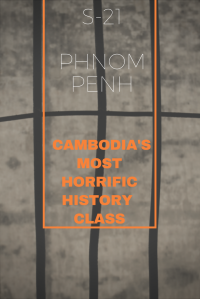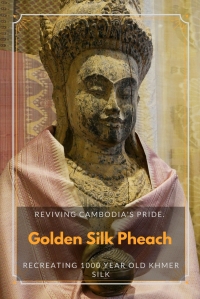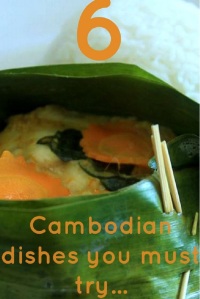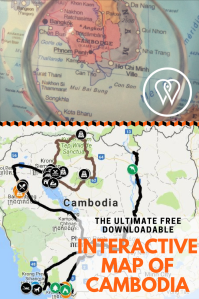It is a group of rather ugly three-story buildings with the typical architecture from the 1960’s surrounding a central yard. Chao Ponhea Yat high school was built in 1962 in the south of Phnom Penh, Cambodia. But on April 17th, 1975, when he marched on Phnom Penh with his Khmer Rouge troops, Pol Pot turned this high school into the S-21 prison, also known as Tuol Sleng, the biggest in Kampuchea Democratic where about 20 000 people were jailed and tortured before being exterminated in the nearby killing fields.
After almost a century of French protectorate, the kingdom of Cambodia was restored in 1953. In the shadow of the Vietnam War (1955-1975), the apparently neutral monarchy allowed the North Vietnamese communist Viet Cong forces to use Cambodia as a sanctuary and for its supply lines, leading to the bombing of the country by the USA. Countryside people fled to the cities to escape the bombs. The population of Phnom Penh plummeted to several million inhabitants. In 1970, US-backed Lon Nol took power after a coup. As a consequence, North Vietnam backed up the Khmer Rouge rebels, a communist formation lead by Pol Pot. Unable to secure the country, Lon Nol was overthrown when the Khmer Rouge walked on Phnom Penh on the 17th of April, 1975. It did not take long for Pol Pot to turn Cambodia into Kampuchea Democratic, what he saw as a utopian communist country. The Khmer Rouge ideology was immediately enforced:
- Self-sufficiency,
- Dictatorship of the proletariat,
- Total economic revolution,
- Complete transformation of Khmer social values.
Within three days, Phnom Penh was emptied: people were forced to abandon the city to walk to their native villages with only their clothes and a rice bowl. Many died on the way during the very hot April month, 1975. The ones who made it to their destination were forced to work in collective rice farms for 12 hours a day or more, without breaks and with only a bit of boiled rice to survive on. The rice production had to be tripled right away for Kampuchea Democratic to become self-sufficient. Many were worked to death, especially the ones from the city who had no experience in farming.
Pure devotion to the communist regime was forced upon the Cambodian people: family values, beliefs, education, religion and Khmer culture had to be left behind, and Cambodia was transformed into a rural, classless society. Families were separated. Forced marriages took place to skyrocket the population to achieve the self-sustainability scheme of Pol Pot. Spied upon during their wedding night, if the marriage was not consumed, death penalty awaited the newlyweds.
The paranoia of Kampuchea Democratic lead to many arrests often for treason. Urban, intellectual and educated people were targeted by the Khmer Rouge: wearing glasses, having soft hands or speaking a different language was sufficient to send one to S-21 or another of the 195 prisons operated during the regime. Victims were tortured and forced to confess having done something against the revolution. The Khmer Rouge stated that education was not important, but only hard work and revolution. School buildings were turned into warehouses or prisons, classrooms into cells for individual or mass detention, school desks were replaced by metal bed frames to torture prisoners with electric shocks or searing hot metal, gym equipment was adapted to hang victims. Gruesome classic torture techniques such as sleep deprivation, pulling finger nails out, waterboarding, and depriving one from one’s dignity by forcing prisoners to eat their own excrements were also conducted along with carefully documented “medical research” such as extracting organs without anaesthetic and draining one’s blood. Many were innocent and made up stories of collaborating with the CIA or KGB to put an end to the unbearable suffering. Starting in 1978, the regime started to collapse because of impossible expectations and mismanagement: Khmer Rouge soldiers themselves started being jailed, tortured and exterminated.
With a knot in my stomach and feeling nauseous, I meet the eyes of the sentenced victims whose black and white ID photographs were taken methodically as they were brought in. In their eyes, I read despair, pain, anger, fear, emptiness, confusion, bewilderment, or numbness. I am walking out of the former classroom of S-21, also known as Tuol Sleng Genocide Museum, which used to be a mass-detention cell. Beyond the stares of these thousands of photographs, instruments of torture, lists of victims, clothes, belongings, skulls and pictures of tortured bodies lying lifeless on the yellow and white tiled floor I am walking on, have left a deep and dark impression on me. Paintings by surviving prisoner Vann Nath, who could save himself thanks to his drawing skills, describe the gruesome imprisonment conditions and sheer cruelty of the executioners. I am standing by the barbwire on the third floor that was preventing victims from committing suicide.
Torn between running away from this horrific place and lingering around to commemorate these victims, I contemplate the city. Tuk-tuks are honking the horn covering the engines of the thousands of mopeds roaming the city. Cranes are shaping the future of dynamic Phnom Penh with new high-rise buildings. The frangipani tree is blooming in the courtyard of S-21 as an homage to the several thousands of victims who were imprisoned and tortured before being slaughtered in the killing fields.
Marcella van Alphen & Claire Lessiau (text & photographs)
Notes:
- The estimated number of casualties of the Khmer Rouge regime is 2 million people, or about a fourth of the country at the time of events, killed by its own.
- After the fall of the Khmer Rouge, Pol Pot fled to Thailand and remained the head of the Khmer Rouge who were still representing Cambodia and seating at the UN in New York City and receiving international financial aid, while the new Cambodian government was ignored.
- The Extraordinary Chambers in the Courts of Cambodia (ECCC) is special court that was put in place to try the senior leaders of the Khmer Rouge. At the time of publishing, three of the top leaders recently received a life imprisonment sentence.
- For an excellent documentary about the forced weddings of the Khmer Rouge regime, refer to the Red Wedding.
- As travelers, we strongly believe that we have a duty to try and understand the history of the countries we visit. Understanding history, and its darkest moments, is a way of commemorating victims while keeping a critical mind on our present. While writing this article, we cannot help but thinking about the alarming events that have been taking place in Syria and bear horrific similarities.
Travel tips:
- If you want to visit S-21, refer to Tuol Sleng Genocide Museum.
- You can visit the Vann Nath’s gallery where some of his paintings are displayed. Vann Nath passed away in 2011 and kept painting until his last day for the world not to forget what happened in S21 and under the Khmer Rouge. The gallery is run by Vann Nath’s family. Refer to the pin on the interactive map below for the specific location.
- Check out this interactive map for the specific details to help you plan your trip and more articles and photos (zoom out) about the area!
Like it? Pin it!

Don’t know where to start? Get inspired:



















21 Comments Add yours